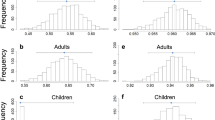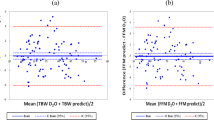Abstract
Background/objectives
Accurately predicting energy requirements form a critical component for initializing dynamic mathematical models of metabolism. The majority of such existing estimates rely on linear regression models that predict total daily energy expenditure (TDEE) from age, gender, height, and body mass, however, there is evidence these predictors obey a power function.
Subjects/methods
Baseline, free-living TDEE measured by doubly labeled water (DLW) in 20 studies with no overlapping subjects were obtained from the core lab at the University of Chicago and the University of Wisconsin-Madison (N = 2501 adults, 628 males, 1873 females). Linear regression models of log-transformed equations of the form: \({\rm{TDEE}} = \alpha _1M^{\beta _1}H^{\beta _2}\) and \({\rm{TDEE}} = {\rm{ln}}\left( {\alpha _1M^{\beta _1 + \gamma _1{\rm{Sex}}}H^{\beta _2 + \gamma _2{\rm{Sex}}}} \right)\) were developed to determine the values of the exponents of body mass (M (kg)) and height (H (cm)) along with a gender effect (Sex). A nonlinear curve fit was performed to develop a power model that also includes age \({\rm{TDEE}} = \alpha _1M^{\beta _1}H^{\beta _2} + \alpha _2{\mathrm{Age}}\).
Results
The power for body mass, β1 = 0.45 and the power for height was β2 = 1.52 in the database with both genders combined. Adding gender reduced these to β1 = 0.43 and β2 = 1.04. All terms were significant (p < 0.01) except for height when including gender. The powers for height in the additive gender-specific models were both closer to 1 and the power for body mass was similar across all models ranging between 0.41 and 0.57.
Conclusions
A nonlinear scaling relationship was found to hold for body mass and needs to be considered when adjusting TDEE for body mass or predicting human energy requirements as a function of body mass especially in individuals with obesity.
This is a preview of subscription content, access via your institution
Access options
Subscribe to this journal
Receive 12 print issues and online access
$259.00 per year
only $21.58 per issue
Buy this article
- Purchase on Springer Link
- Instant access to full article PDF
Prices may be subject to local taxes which are calculated during checkout



Similar content being viewed by others
References
Reeves MM, Capra S. Predicting energy requirements in the clinical setting: are current methods evidence based? Nutr Rev. 2003;61:143–51.
Tharion WJ, Lieberman HR, Montain SJ, Young AJ, Baker-Fulco CJ, Delany JP, et al. Energy requirements of military personnel. Appetite. 2005;44:47–65. https://doi.org/10.1016/j.appet.2003.11.010.
Christiansen E, Garby L. Prediction of body weight changes caused by changes in energy balance. Eur J Clin Invest. 2002;32:826–30.
Hall KD, Sacks G, Chandramohan D, Chow CC, Wang YC, Gortmaker SL, et al. Quantification of the effect of energy imbalance on bodyweight. Lancet. 2011;378:826–37. https://doi.org/10.1016/S0140-6736(11)60812-X.
Kozusko FP. Body weight setpoint, metabolic adaption and human starvation. Bull Math Biol. 2001;63:393–403. https://doi.org/10.1006/bulm.2001.0229.
Westerterp KR, Donkers JH, Fredrix EW, Boekhoudt P. Energy intake, physical activity and body weight: a simulation model. Br J Nutr. 1995;73:337–47.
Vinken AG, Bathalon GP, Sawaya AL, Dallal GE, Tucker KL, Roberts SB. Equations for predicting the energy requirements of healthy adults aged 18–81 y. Am J Clin Nutr. 1999;69:920–6.
Heymsfield SB, Pietrobelli A. Body size and human energy requirements: reduced mass-specific total energy expenditure in tall adults. Am J Hum Biol. 2010;22:301–9. https://doi.org/10.1002/ajhb.20985.
Kleiber M. Body size and metabolic rate. Physiol Rev. 1947;27:511–41.
Maino JL, Kearney MR, Nisbet RM, Kooijman SA. Reconciling theories for metabolic scaling. J Anim Ecol. 2014;803:20–9. https://doi.org/10.1111/1365-2656.12085.
West GB, Brown JH, Enquist BJ. A general model for the origin of allometric scaling laws in biology. Science. 1997;276:122-6.
Schoeller DA, van Santen E. Measurement of energy expenditure in humans by doubly labeled water method. J Appl Physiol Respir Environ Exerc Physiol. 1982;53:955–9. https://doi.org/10.1152/jappl.1982.53.4.955.
Trumbo P, Schlicker S, Yates AA, Poos M. Food, Nutrition Board of the Institute of Medicine TNA. Dietary reference intakes for energy, carbohydrate, fiber, fat, fatty acids, cholesterol, protein and amino acids. J Am Diet Assoc. 2002;102:1621–30.
R Core Team, R: A Language and Environment for Statistical Computing, R Foundation for Statistical Computing, Vienna, Austria, 2018, https://www.r-project.org/.
Muller MJ, Geisler C, Hubers M, Pourhassan M, Braun W, Bosy-Westphal A. Normalizing resting energy expenditure across the life course in humans: challenges and hopes. Eur J Clin Nutr. 2018;72:628–37. https://doi.org/10.1038/s41430-018-0151-9.
Muller MJ, Langemann D, Gehrke I, Later W, Heller M, Gluer CC, et al. Effect of constitution on mass of individual organs and their association with metabolic rate in humans--a detailed view on allometric scaling. PLoS ONE. 2011;6:e22732 https://doi.org/10.1371/journal.pone.0022732.
Schoeller DA, van Santen E, Peterson DW, Dietz W, Jaspan J, Klein PD. Total body water measurement in humans with 18O and 2H labeled water. Am J Clin Nutr. 1980;33:2686–93. https://doi.org/10.1093/ajcn/33.12.2686.
Rubner M, Joy RJT, Chambers WH. A nutrition foundations’ reprint of The laws of energy consumption in nutrition. New York: Academic Press; 1982; p. 371.
Rubner M. The laws of energy consumption in nutrition. Natick, Mass.: U.S. Army Research Institute of Environmental Medicine; 1968; p. 371.
Author information
Authors and Affiliations
Corresponding author
Ethics declarations
Conflict of interest
The authors declare that they have no conflict of interest.
Rights and permissions
About this article
Cite this article
Thomas, D.M., Watts, K., Friedman, S. et al. Modelling the metabolism: allometric relationships between total daily energy expenditure, body mass, and height. Eur J Clin Nutr 73, 763–769 (2019). https://doi.org/10.1038/s41430-018-0230-y
Received:
Revised:
Accepted:
Published:
Issue Date:
DOI: https://doi.org/10.1038/s41430-018-0230-y



